October 14, 1983: “Surprise” snowstorm covers east central Minnesota. The Twin Cities measured 13.6 inches. Brilliant blue skies and bright sun the morning after.
October 14, 1886: St. Cloud-Sauk Rapids tornado. It left 72 people dead. 80 percent of all buildings in Sauk Rapids were leveled as the tornado expanded to 800 yards across. When it crossed the Mississippi it knocked down two iron spans of a wagon bridge and local witnesses said the river was “swept dry” during the tornado crossing. There was 300,000 dollars damage in Sauk Rapids and only 4,000 dollars worth was insured. The forecast for that day was for local rains and slightly warmer with highs in the 50s.
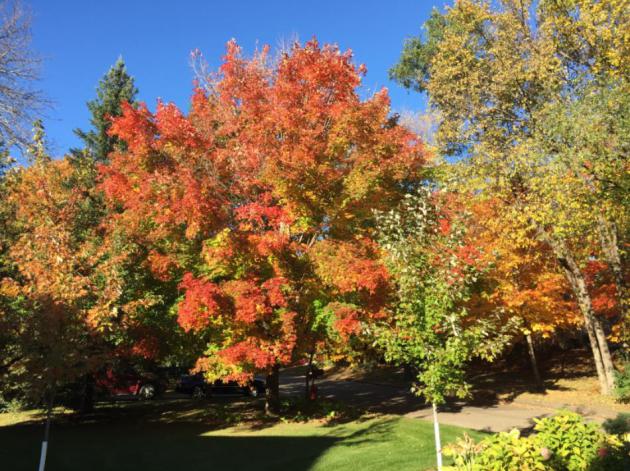
Big Temperature Swings Brewing
Colors Peaking Soon
“Autumn…the year’s last, loveliest smile” wrote William Cullen Bryant. Nature’s grand finale is in full play; a splash of Crayola color on the trees, the air cool and clean. Fewer bugs showing up on Doppler too.
October can be a manic month, capable of 80s and 90s, but also towering drifts of snow. NOAA records show pioneers at Fort Snelling digging out from 11 inches of snow on this date in 1820. In 1880 a blizzard in western Minnesota left Canby buried under 20 FOOT drifts, which didn’t melt until the following spring. Autumn 2015 has been a blessing, by comparison.
No drama brewing, but get ready for big temperature extremes and more wind. Another slap of Canadian air sets the stage for the first widespread freeze of the season Saturday morning. So long ragweed. Good riddance.
Strong south winds on the backside of a high pressure bubble warm us into the 60s early next week; 70F possible Monday before a storm spins up with rain late Tuesday into Wednesday. It won’t be cold enough for s-s-snow looking out 2 weeks or so. After that all bets are off.
Enjoy the quiet spell!

A Good Chance of “Freezing”. Models are in fairly tight alignment showing temperatures at Spring Park (and most other close-in suburbs) dipping below freezing for a few hours. Not sure it’ll be a hard freeze in the immediate metro, but if you have some plants you want to keep around awhile, cover them up, bring them indoors, or write them off. Graphic: Aeris Enterprise.

7 AM Saturday Morning. NOAA’s GFS model shows sub-freezing temperatures over most of Wisconsin and a big chunk of Minnesota, coming roughly 10 days later than average this year.

Bouncing Back. After a frosty start Saturday temperatures slowly moderate, reaching near 60F Sunday and well into the 60s Monday; the GFS is predicting 73F at 2 PM Monday (which assumes some sun and no rain at that time).
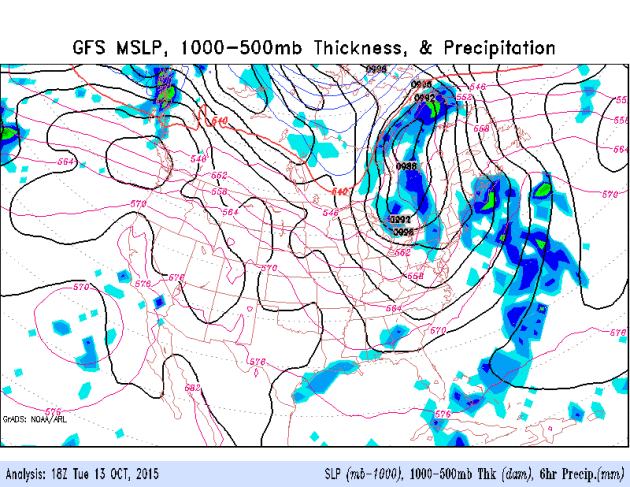
10-Day Guidance. Here’s a closer look at the GFS model from last night, a tight pressure gradient whipping up strong (15-25) mph winds Sunday and Monday as mild air tries to surge north. By the end of the period the GFS tries to bring a tropical depression across the Gulf of Mexico – not sure that’s real (yet). Stay tuned.
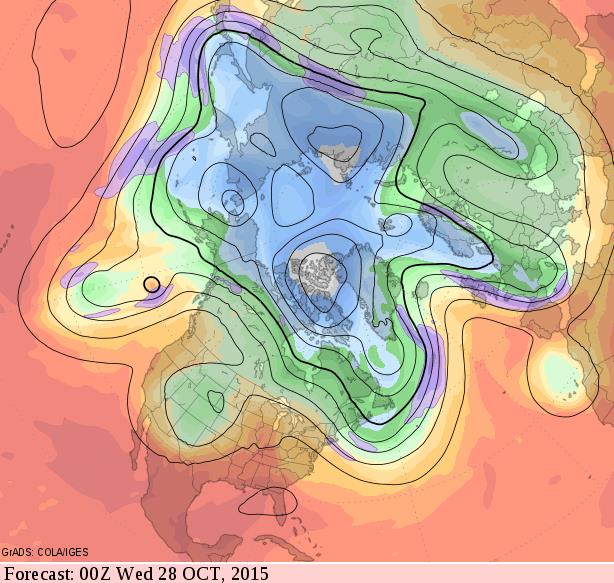
Mild Bias Continues. October is running about 3F warmer than average in the Twin Cities, to date. In spite of a few (fleeting) cold snaps I still detect a mild bias in the maps looking out 2 weeks or so. 500 mb winds valid Tuesday evening, October 27, courtesy of NOAA’s GFS. Source: GrADS:COLA/IGES.
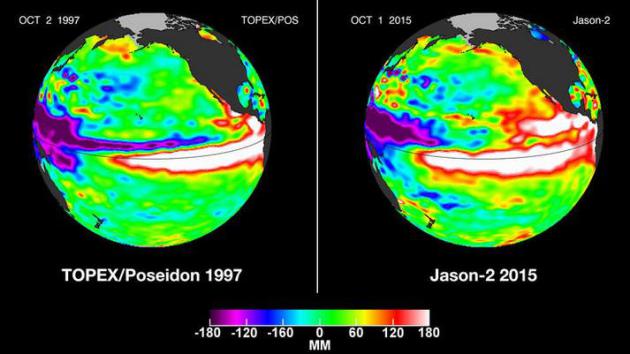
Massive El Nino Is Now “Too Big to Fail”, Says Scientist. The Los Angeles Times has the story – here’s the introduction: “An El Niño that is among the strongest on record is gaining strength in the Pacific Ocean, and climate scientists say California is likely to face a wet winter. “There’s no longer a possibility that El Niño wimps out at this point. It’s too big to fail,” said Bill Patzert, climatologist for NASA’s Jet Propulsion Laboratory in La Cañada Flintridge. “And the winter over North America is definitely not going to be normal,” he said. Just three weeks ago, the National Weather Service’s Climate Prediction Center raised the odds of California getting doused with a wetter-than-average winter...”
Graphic credit above: “Satellite images comparing Oct. 1, 2015, and Oct. 2, 1997, show large areas of white, which indicate high sea levels — a reflection of high sea temperatures. The images show how this year’s El Nino could be as powerful as the one in 1997, the strongest El Nino on record.” (NASA Jet Propulsion Laboratory).
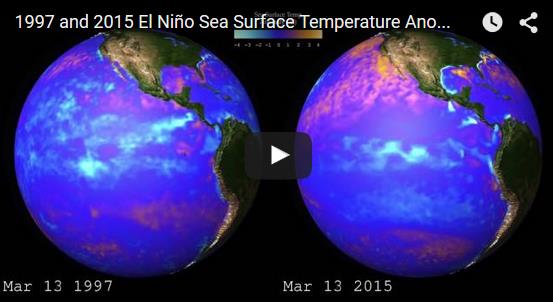
1997 vs. 2015: Animation Compares El Ninos, Side-by-Side. Here’s a link to an animation and story from Climate Central: “…On Tuesday, the World Meteorological Organization declared this El Nino a strong one, and some scientists have noted that sea surface temperatures in a key part of the eastern Pacific are higher than in previous events by this point of the year. Forecasters with the National Oceanic and Atmospheric Administration and Columbia University said in their August update that temperatures in that region could reach more than 3.5°F above normal when this event peaks in the winter, something only recorded three times in the 65 years of record-keeping, including the 1997-1998 event (as well as 1982-1983 and 1972-1973)…”

Weather Channel Releases Names of Upcoming Winter Storms. Where’s Bubba? I want a storm called “Bubba” before I meet my maker. Here’s an excerpt from a story at Capital Weather Gang: “…Every fall, the Weather Channel’s winter names announcement is met with reactions ranging from skepticism to vitriol. But they’re not backing away from the project, which Mary Glackin, senior vice president for public-private partnerships at the Weather Company, says is the right move for public safety and the weather industry. “I would like to see us reach some solution as a whole enterprise,” Glackin told The Washington Post. She used Hurricane Joaquin and South Carolina’s recent flooding disaster as an example of events where, despite agreement among meteorologists, the public can still fail to grasp the most critical impact message…”
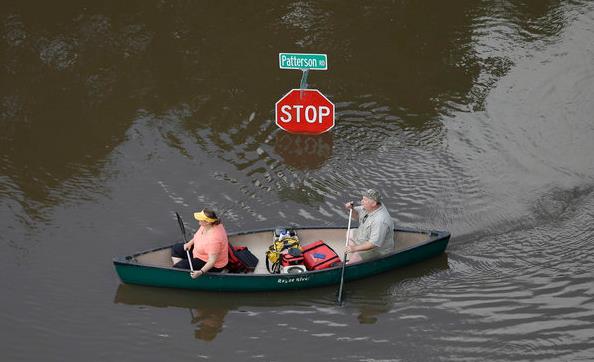
2015 Has Been A Year of Record-Breaking U.S. Weather Events. It’s a fairly long list – here’s an excerpt from Huffington Post: “Catastrophic flooding in South Carolina since last week shattered state rainfall records and shocked longtime residents and officials, who said they’ve never seen rain so powerful. But it’s hardly the first extreme, record-breaking weather event in the U.S. this year. Floods, hurricanes, wildfires and other extreme events are becoming more frequent and more intense because of climate change, experts warn, and that’s never been more apparent than in 2015. Here’s a look at some of the record-breaking weather-related events that have hit the U.S. this year...”
Photo credit:
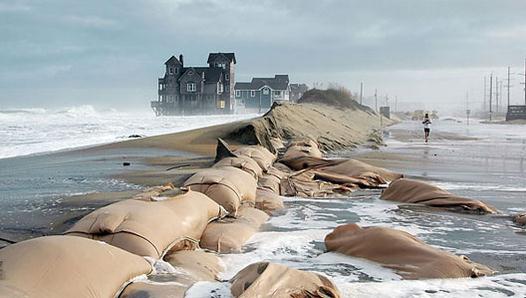
The American Cities Most Threatened by Rising Sea Levels. Not a climate model, but actual observations: sea levels are rising – the question is how much more, and how quickly? Here’s an excerpt from Mashable: “…The cities of Jacksonville, Virginia Beach, Sacramento and Miami follow New York in terms of the size of the population that could avoid submergence if steep carbon cuts were to take place in the next couple of decades versus a business-as-usual course, according to data provided by the study’s authors. In Virginia Beach, for example, the difference between a high and low emissions scenario means the contrast between seeing the entire city submerged under the Atlantic, and only a portion of it reclaimed by the sea. The study raises the possibility that the cultural legacy of cities ranging from New York to Boston to Miami and New Orleans are at existential risk...” (File photo: Andrew Demp, Yale).

Allergies Are Becoming More Frequent. Why? Here’s an excerpt of an interesting post from The Conversation and Huffpost Healthy Living: “…The reasons for the rising number of allergies are not fully understood, but here are six theories.
1) Decreased exposure to infections or microbes – or both – in early life could lead to an increased risk of allergy. This is commonly referred to as the hygiene hypothesis, first suggested in 1989. Research showing children who have close contact with pets or livestock and those who come from larger families are less likely to develop allergies have indirectly supported the hygiene hypothesis...”

Renewable Energy’s Potential May Be Understated. The headline I thought I’d never see at The Wall Street Journal; here’s an excerpt: “…The experience of California and other states with high concentrations of solar and wind, such as Hawaii, is challenging long-held assumptions about the limits of renewable energy. As the boundary of what is considered possible expands, so does the momentum around investment in new technology and resources. “You’ll hear numbers [that] people bandy about and most of them are wrong: ‘We know we can get to at least 35% or 40%,’ ” says Haresh Kamath, an expert in energy storage and distributed generation with the Electric Power Research Institute in Palo Alto, Calif...”
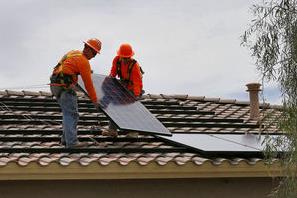
Big Utilities Enter Market for Small Rooftop Solar. The Santa Fe New Mexican has the story – here’s a link and excerpt: “Traditional power companies are getting into small-scale solar energy and competing for space on your rooftop. The emerging competition comes as utilities and smaller solar installers fight over the future of the U.S. energy system. While the market for residential solar power remains a financial drop in the bucket for a big utility, the installation of solar panels overall grew by more than 50 percent in 2014 and is on track for another record-breaking year at time when the traditional utility business is pretty flat...”
Photo credit above: “Electricians Adam Hall, right, and Steven Gabert, install solar panels in July on a roof in Goodyear, Ariz. Traditional power companies are getting into small-scale solar energy and competing for space. The emerging competition comes as utilities and smaller solar installers fight over the future of the U.S. energy system.” Matt York/Associated Press file photo.
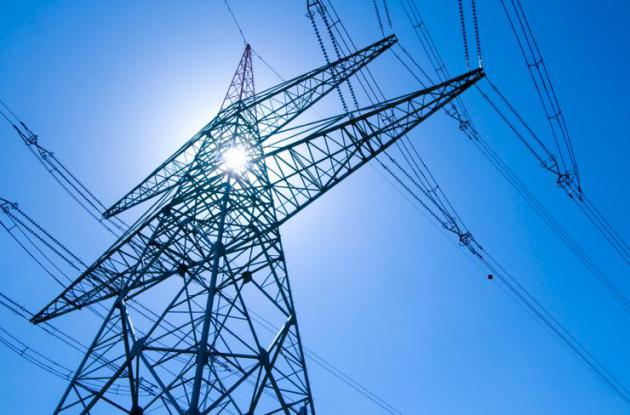
With Market On Their Side, Electric Utilities Skip Fight Against Carbon Rule. Renewables and natural gas are now helping utilities lower their costs (and carbon emissions), as reported by The Wall Street Journal: “U.S. coal companies and at least 16 state governments are working on challenges to the Obama administration’s new rule limiting carbon emissions from power plants. Most electric utilities have a different strategy: They are embracing it. From Dominion Resources Inc. in Virginia to Dynegy Inc. in Houston to Ohio’s FirstEnergy Corp. , electricity producers say they plan to comply rather than contest the regulation. The main reason, executives and experts say, is that economic forces are pushing the power industry inexorably toward a lower-carbon future…” (File image: AARP).

It Finally Occurred To Someone To Crowdsource The Weather. Motherboard has the details; here’s a link and excerpt: “There’s a big hole in weather forecasting nowadays: none of them really ask the guy on the street how it’s feeling outside. And that untapped avenue is the target for Sunshine, a mobile weather app released last week on the iOS App Store. Unlike a traditional weather app, Sunshine shows you a local street map with crowdsourced reports from people using it to report local sky conditions…”



THURSDAY: Cloudier and cooler, passing shower? Winds: NW 10-20. High: near 60 (falling into the 50s)
FRIDAY: More clouds than sun, brisk, light jacket needed. Winds: NW 10-15. Wake-up: 38. High: near 50
SATURDAY: Frosty start. Bright sunshine. Winds: SE 5-10. Wake-up: 31. High: 53
SUNDAY: Sunny, windy and milder. Winds: SE 15-25. Wake-up: 37. High: near 60
MONDAY: Some lukewarm early, PM shower possible. Wake-up: 49. High: 70
TUESDAY: Early sun, late showers. Wake-up: 53. High: 63
Climate Stories…
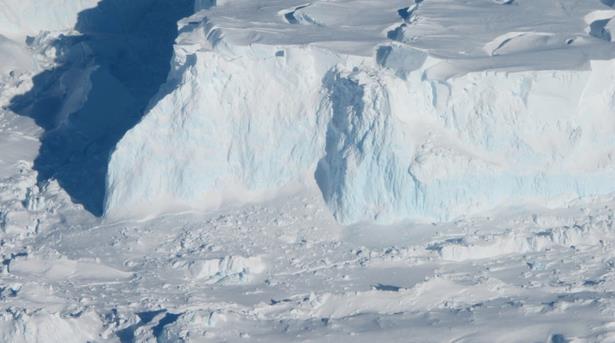
Why Scientists Are So Worried About the Ice Shelves of Antarctica. Tipping points – we don’t know what we don’t know. If anything the rate of melting of Greenland and sea ice in Antarctica has been taking place faster than the climate models predicted. Here’s an excerpt from The Washington Post: “…They found that under both scenarios, Antarctic-wide surface melt doubles by the year 2050, with the amount of meltwater produced coming close to 200 gigatons per year (a gigaton is a billion metric tons). This is a troubling finding, said Nerilie Abram, a researcher from the Centre of Excellence for Climate System Science at Australian National University who was not involved with the study, in an e-mail to The Post. But, she said, “I think that the more interesting result is to look at the huge divergence in predicted Antarctic ice melt during the second half of the century...”
Photo credit above: “The photograph above shows an edge of the Thwaites Ice Shelf.” (Jim Yungel/NASA)
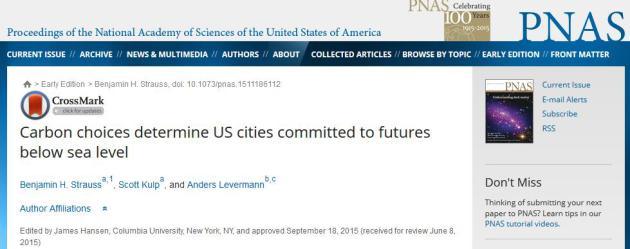
Carbon Choices Determine U.S. Cities Committed to Futures Below Sea Level. Here is an excerpt of the paper abstract, courtesy of PNAS: “As greenhouse gas emissions continue to rise, the window to limit global warming below 2 °C appears to be closing. Associated projections for sea-level rise generally range near or below 1 m by 2100. However, paleontological and modeling evidence indicates long-term sea-level sensitivity to warming that is roughly an order of magnitude higher. Here we develop relationships between cumulative carbon emissions and long-term sea-level commitment and explore implications for the future of coastal developments in the United States…”
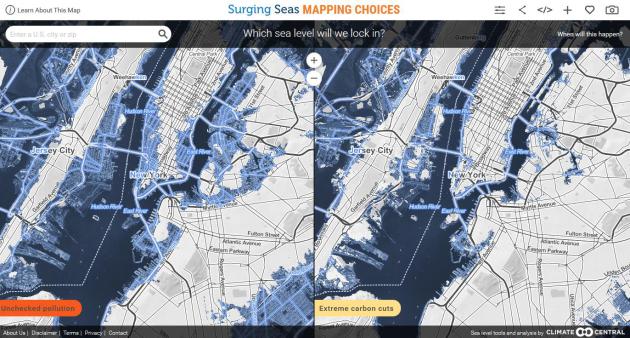
Sea Level Analyzer. How quickly we curtail carbon emissions will determine the amount of sea level rise that’s locked in for the future. Climate Central has a tool that helps to visualize best-case, and worst-case scenarios going forward.
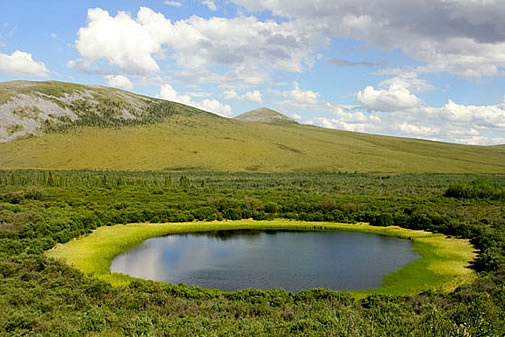
Methane Release From Melting Permafrost Could Trigger Dangerous Global Warming. Here’s a snippet from The Guardian: “…To put this in perspective, permafrost contains almost twice as much carbon as is present in the atmosphere. In the rapidly warming Arctic (warming twice as fast as the globe as a whole), the upper layers of this frozen soil begin to thaw, allowing deposited organic material to decompose. The plant material, which has accumulated over thousands of years, is concentrated in to upper layers (half of it is in the top 10 feet). There is a network of monitoring stations that are measuring ground temperatures have detected a significant heating trend over the past few decades and so has the active layer thickness…” (File image: NASA).

Biology: Climate Change a “Threat Multiplier” on Stressors. Here’s an excerpt of an Op-Ed at The Columbus Dispatch: “…According to a New York Times report, Kerry told more than 450 delegates, “You think migration is a challenge in Europe today because of extremism, wait until you see what happens when there’s an absence of water, an absence of food or one tribe fighting against another for mere survival.” A growing number of research groups and agencies suggest we’re already there. Those groups argue that environmental factors, especially drought, have caused crop failures, increased food costs and migration from parched, rural areas to Middle East urban centers. Once there, those agricultural refugees exacerbated civil unrest that led to the Arab Spring, a wave of increasingly violent protests...” (File: AP).
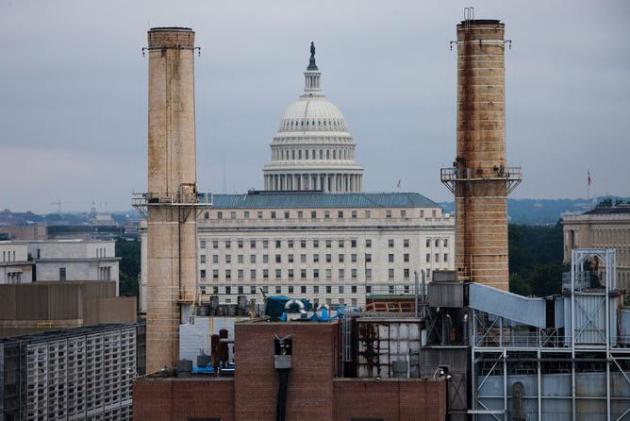
Bringing Republicans to the Climate Change Table. Here’s an excerpt from a story at The New York Times: “…Is it possible to turn the Republican Party around? It won’t be easy. Republican leaders like Mitch McConnell of Kentucky are wedded to defending a declining coal industry and advancing the interests of oil companies, most clearly in their support for the Keystone pipeline. Many of the party’s lawmakers and presidential candidates get a lot of money from people like the Koch brothers, who have multimillion-dollar contributions for anybody who will stand against efforts to curb the use of fossil fuels. But there is more than money to the story. For many Republicans, climate change poses an existential quagmire…”
Photo credit above: “Smokestacks of the Capitol Power Plant frame the Capitol building. Republican Party views on climate change today stand in sharp contrast to the mainstream position of the party less than a decade ago.” Credit Christopher Gregory for The New York Times

The Most Pessimistic Climate Change Scientist Has Had a Sudden Change of Heart. Will technological innovation and renewables trending cheaper than fossil fuels save the day? Here’s an excerpt from The Independent: “…His optimism is founded on the breakneck speed of innovation in wind and solar power in the past two to three years, which means that renewable energy is being deployed on a massive scale and, crucially, at a cost roughly comparable to fossil fuels. Only last week new figures showed that the cost of electricity produced by onshore windfarms in the UK has fallen so much that for the first time it is now cheaper than fossil-fuel energy...”
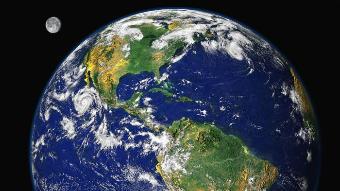
Ex-Republican Meteorologist Calls For End to Partisan Divide Over Climate Science. This debate has become less about data, evidence and science and more about “winning”. Here’s an excerpt of a Jason Samenow column at The Capital Weather Gang: “…Fishel said in an email message that due to overall state of party politics, after 30 years, he is no longer a Republican and considers himself unaffiliated. “I hate agendas, and there are agendas on both sides of the climate change debate which I abhor and have no time for,” Fishel’s essay begins. “But once you cut through all of that, much of which is ideological and political, you are left with hard science.…”

Choose Science, Stewardship in Understanding Climate Change. My friend, Chief Meteorologist Greg Fishel at WRAL-TV in Raleigh, North Carolina wrote an article explaining the evolution of his views on climate science; here’s an excerpt: “…In closing, I believe science is a gift from God. We benefit from science in our daily lives 1,000 times over through all the conveniences we enjoy. Why have we chosen to turn our back on science when it comes to basic chemistry and physics? It is time to stop listening to the disingenuous cherry-pickers and start taking responsibility for learning the truth about climate change. For those of you who are ardent skeptics, it’s going to be uncomfortable. I know, I have gone through the entire process. But in my mind, I didn’t make a mistake, I simply grew as a human being. There aren’t too many experiences in life that can top that.”
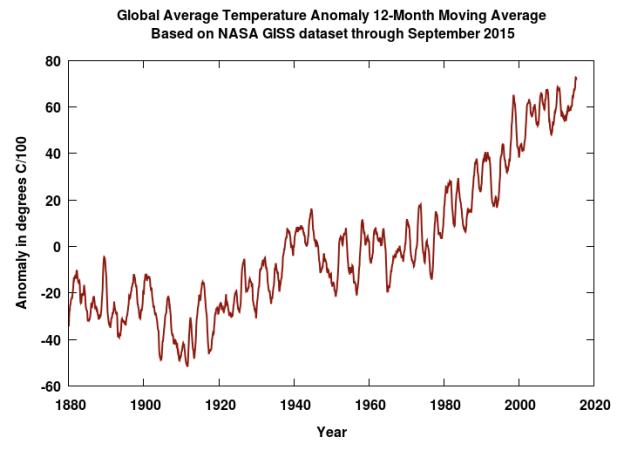
September 2015 Continues Upward Trend in Global Temperatures. Here’s an excerpt of a post from Greg Laden at scienceblogs.com: “The NASA GISS global surface measurement for September is out. I don’t know off hand if there are corrections for earlier months. The data for September show the month as the same as the earlier month, 0.81 degrees C anomaly. The current best estimate of the warming of the Earth’s surface from anthropogenic global warming, using the NASA data and a 12 month running mean, looks like this...”

